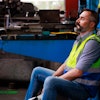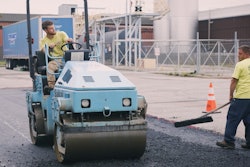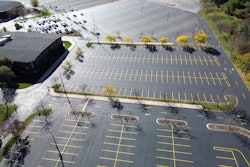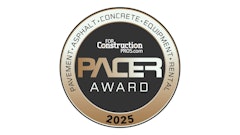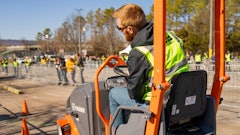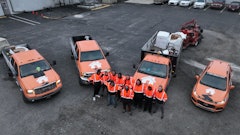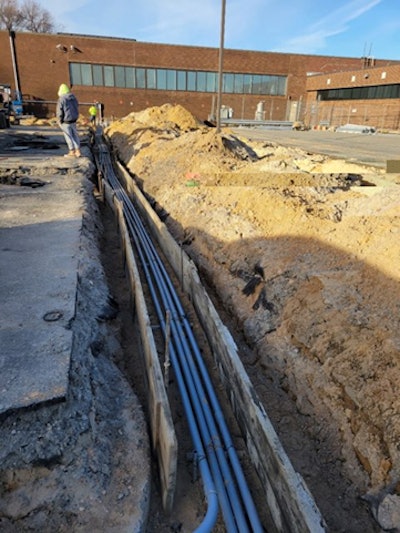
The 2025 Paving: Parking Lot Award goes to a project that was not for the faint of heart: a major paving and infrastructure project managed by Royal Pavement Solutions of Islip, N.Y.
Royal Pavement orchestrated the complete replacement of a 140,000-square-foot parking lot -- including curbing, sidewalks, trenching, drainage upgrades, a loading dock rebuild and installation of electric vehicle (EV) chargers -- at a busy post office hub, a project that took roughly a year to complete.
Royal began the planning and bidding in the fourth quarter of 2023 and started construction in 2024.
“We were awarded this project in December of last year (2023), and this had been in the works for a couple months prior. We had a few revisions to the plans and specifications, and by the time that we were awarded the project at the end of December, we already had our first deadline to meet in January,” said Ethan Lodato, a Royal Pavement project manager.
Royal Pavement’s crew followed strict federal rules and stiff scheduling requirements. In January, for example, the Royal Pavement crew worked side-by-side with electricians to install charging stations for EVs that were being delivered at the end of the month. They worked through snow, sleet, ice and more, during those winter months.
“We don't really like to do permanent asphalt work in January in the Northeast up here,” he said. “We had to kind of work around, from the jump -- what kind of what plants were open, meeting that first deadline.”
The project was so complex, it took crews until October to complete.
“It was really ground up work, as in the parking lot itself, in almost all areas, we were replacing base, binder, top to depths of approximately 12 inches,” Lodato said. “Even further below that, we were working in conjunction with an electrician installing conduits.”
The project required extensive trenching to install the EV charging stations.
“We were responsible for thousands of feet of trenching, a lot of which had concrete encasements of these buried conduits, with the broader general goal of installing about 50 chargers with this electrician for electric vehicles in the parking lot,” Lodato said.
The parking lot itself was redesigned and engineered to rework the grading and prevent puddling. The project also involved the construction of retaining and recon block walls, as well as the installation of more than 100 bollards with custom metal sleeves. Throughout each phase, there were various weather and project surprises along the way. The most unexpected development was during the replacement of the loading dock. While demolishing the existing loading dock, they found another loading dock, which had been buried within the existing loading dock. The additional loading dock had thousands of yards of unsuitable base containing soil and clay that needed to be removed and replaced.
“The loading dock called for removal and replacement and a couple of dry wells to be installed there,” Lodato said. “When we get the existing ripped out and start digging the dry wells, lo and behold, we hit some concrete underneath, anywhere from 1 to 3 feet deep, and you get the area exposed. The previous loading dock was buried underneath the one that we ripped out.”
Clearly, all the old loading dock infrastructure needed to be removed.
“There were some old retaining walls having to do with the loading dock, the existing concrete from the previous loading dock that they must have just buried and poured on top of. That definitely added a lot of time and effort, first figuring out what exactly we were up against in that area that had been previously buried,” Lodato said. “There were some great efforts in removal of that previously buried loading dock to allow for new drains, interconnecting that system and then properly installing the new one on good, fresh base.”
Throughout the project, crews had kept an eye on the single entry/egress to the post office, which they couldn’t close off to traffic while the post office was in operation. As the project neared its end, Royal Pavement helped plan and coordinate work to be completed on Columbus Day in October. During that federal holiday, the post office was closed and was one of the few opportunities the contractors had to finish that entryway/egress. Royal Pavement created a plan to accomplish everything in a day, knowing that postal trucks would be up and running the following day. They devised a project timeline with pre-planned truck routes, material logistics, and redundant resources to avoid delays. They had extra equipment on site in case something broke down.
“We had redundancy,” said Kenny Roy, owner of Royal Pavement Solutions. “If something goes down, we have a backup, every kind of backup, so that no matter what happened, we felt really confident, short of a catastrophic event, that we should be okay.”
That confidence comes from pre-planning, they said.
“Kenny and I had a meeting beforehand where we discussed everything and had everything planned down to literally within five minutes of loads out, travel time to recycling facilities, travel time to the asphalt plant,” Lodato said. “We were recycling the base material at one facility, then picking up the RCA at another facility and then the asphalt from another facility.”
“Every single truck, we knew exactly where it was going to be at each point,” Roy said.
Roy and Lodato credit a large part of the project's success to Hector Polanco, operations manager, and Donna Falzolgher, office manager at the company.
"They were really instrumental in the project," Lodato said. "I firmly believe it would not have gone as successfully without their support in their respective roles."
In all, the project involved 10 highly planned phases to complete. Despite the challenges, the project was completed on time. Royal Pavement continues to grow and find success with new projects. In 2024, Royal Pavement increased its workforce by 15% and added new equipment, including pavers, rollers, and asphalt tools, to handle the growing demands of new and existing projects.
Royal Pavement Solutions was started in 2019 by Roy, a third-generation paver. The company is a continuation of the family business started by his grandfather in 1963.



